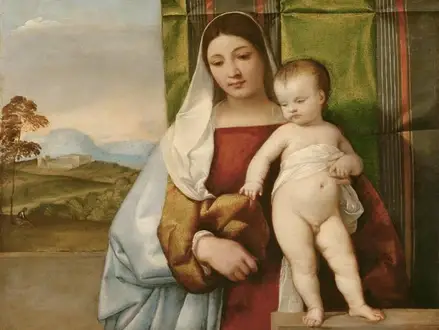Title of Artwork: “The Gipsy Madonna”

Artwork by Titian
Year Created 1510-1511
Summary of The Gipsy Madonna
An oil panel painting depicting The Gipsy Madonna by Titian, now housed in Vienna’s Kunsthistorische Museum, is known as the Gypsy Madonna. It’s a painting meant for a home or office, not a religious institution.
All About The Gipsy Madonna
Even when reversed, the composition is reminiscent of Giovanni Bellini works, such as one in the Detroit Institute of Arts, and has been interpreted as an attempt to outdo the much older master. In the early 20th century, the style was frequently attributed to Giorgione because of its resemblance to his work.
Although Titian used a similar figure in later Madonnas, the “harmonious fullness and slow gravity of form” used by the Virgin is particularly notable. Although Titian completed the landscape after Giorgione’s death in 1510, it is virtually identical to the left-most section of the background of Giorgione’s Dresden Venus.
It’s important to pay close attention to the folds in the cloth of honour in the right background (they were often stored folded up). As in many paintings of Madonnas enthroned, these hung behind the thrones and this implies that an unoccupied throne is hidden to the right in this painting.
Similar to the Bellini in Detroit, As a result, it falls somewhere in the middle of earlier, more formal Madonnas enthroned on thrones and more recent depictions of the Virgin and Child in an informal landscape setting.
The horizontal “landscape” format used in this painting is a continuation of the practise of Bellini and his followers of showing glimpses of landscape to the sides of the painting, which is usually cut off by a lower parapet.
The painting was dubbed the “Gypsy Madonna” in the late 1800s due to the Virgin’s alleged “dusky complexion and her dark hair and eyes. In comparison to other Madonnas, she appears to be in her early twenties, and the Child’s hands are occupied with his mother’s fingers and her dress (this is a difference to the Bellini).
As Sidney J. Freedburg points out, this is the case:
Titian, who was twenty-one at the time, is shown in this painting, despite his debts to Bellini and Giorgione, forging ahead with his own identity and style.
There are numerous differences between the original and the finished painting, according to the results of a technical examination. Titian, in contrast to Bellini, “used only summary strokes made with a fairly wide brush with thin wash shading” as his guidelines. The Child’s head was originally turned away from the viewer, but this was later changed.
It is very likely that the painting was part of the collection of Bartolomeo della Nave, who sold it to the Duke of Hamilton in Venice in 1636 and brought it to London. After Hamilton’s death in 1659, Archduke Leopold Wilhelm of Austria purchased it in Brussels and it soon became part of Vienna’s imperial collection.
Information Citations
En.wikipedia.org, https://en.wikipedia.org/.
























